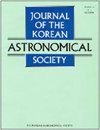Intrinsic Brightness Temperatures of Compact Radio Jets as a Function of Frequency
IF 0.8
4区 物理与天体物理
Q3 ASTRONOMY & ASTROPHYSICS
引用次数: 8
Abstract
We present results of our investigation of the radio intrinsic brightness temperatures of compact radio jets. The intrinsic brightness temperatures of about 100 compact radio jets at 2, 5, 8, 15, and 86 GHz are estimated based on large VLBI surveys conducted in 2001-2003 (or in 1996 for the 5 GHz sample). The multi-frequency intrinsic brightness temperatures of the sample of jets are determined by a statistical method relating the observed brightness temperatures with the maximal apparent jet speeds, assuming one representative intrinsic brightness temperature for a sample of jets at each observing frequency. By investigating the observed brightness temperatures at 15 GHz in multiple epochs, we find that the determination of the intrinsic brightness temperature for our sample is affected by the flux density variability of individual jets at time scales of a few years. This implies that it is important to use contemporaneous VLBI observations for the multi-frequency analysis of intrinsic brightness temperatures. Since our analysis is based on the VLBI observations conducted in 2001-2003, the results are not strongly affected by the flux density variability. We find that the intrinsic brightness temperature T 0 increases as T 0 ∝ ν ξ obs with ξ = 0.7 below a critical frequency ν c ? 9 GHz where the energy loss begins to dominate the emission. Above ν c , T 0 decreases with ξ = -1.2, supporting the decelerating jet model or particle cascade model. We also find that the peak value of T 0 ? 3.4 × 10 10 K is close to the equipartition temperature, implying that the VLBI cores observable at 2-86 GHz may be representing jet regions where the magnetic field energy dominates the total energy in jets.紧凑型射电喷流的本征亮度温度与频率的关系
我们提出了我们对紧凑型射电喷流的射电本征亮度温度的研究结果。根据2001-2003年(或1996年对5 GHz样本)进行的大型VLBI调查,估计了大约100个紧凑射电喷流在2、5、8、15和86 GHz的固有亮度温度。射流样品的多频本征亮度温度是通过将观测到的亮度温度与最大视射流速度联系起来的统计方法确定的,假设在每个观测频率下射流样品有一个具有代表性的本征亮度温度。通过对15ghz多个时期观测到的亮度温度的研究,我们发现样品的本征亮度温度的确定受到单个喷流在几年时间尺度上的通量密度变化的影响。这意味着使用同时期的VLBI观测来进行多频分析是很重要的。由于我们的分析是基于2001-2003年进行的VLBI观测,因此结果不受通量密度变化的强烈影响。我们发现本征亮度温度t0随着t0∝ν ξ obs而增大,ξ = 0.7,低于临界频率ν c ?9ghz时,能量损失开始主导发射。在ν c以上,t0随ξ = -1.2而减小,支持减速射流模型或粒子级联模型。我们还发现t0的峰值?3.4 × 10 10 K接近均分温度,说明在2-86 GHz观测到的VLBI核可能代表了磁场能量占射流总能量主导的射流区域。
本文章由计算机程序翻译,如有差异,请以英文原文为准。
求助全文
约1分钟内获得全文
求助全文
来源期刊

Journal of the Korean Astronomical Society
地学天文-天文与天体物理
CiteScore
1.30
自引率
10.00%
发文量
0
审稿时长
>12 weeks
期刊介绍:
JKAS is an international scientific journal publishing papers in all fields of astronomy and astrophysics. All manuscripts are subject to the scrutiny of referees. Manuscripts submitted to JKAS must comply with the ethics policy of JKAS. Six regular issues are published each year on February 28, April 30, June 30, August 31, October 31, and December 31. One year''s issues compose one volume.
 求助内容:
求助内容: 应助结果提醒方式:
应助结果提醒方式:


